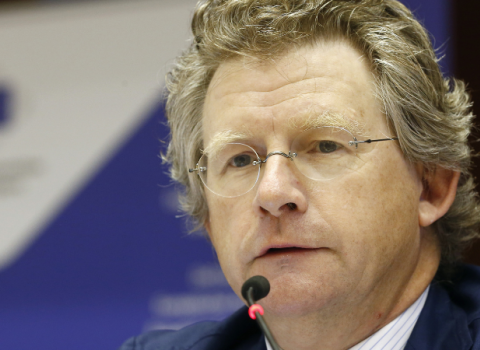The former Italian prime minister wants more breakthrough innovation, using a radically different model

Coming soon to the EU? The BigDog robot is one of the many inventions to have been supported by Darpa. Photo credits: DARPA
This week’s enormous report into EU competitiveness by former Italian prime minister Mario Draghi is chock full of solutions to Europe’s economic woes, from making mega-mergers easier to new common debt.
But for research and innovation, probably the most radical Draghi suggestion is that the EU create an innovation agency modelled on the American Defense Advanced Research Projects Agency (Darpa).
“Support for breakthrough disruptive innovation remains limited,” the report warns. “Even though Horizon Europe’s mission is to promote disruptive research and innovation, the programme is neither sufficiently funded nor well-structured for the purpose.”
Calls to create Arpa-like bodies have become ubiquitous to the point of cliché over the past decade, as countries try to resuscitate innovation by creating new, more agile agencies with more internal freedom to back radical technologies.
Following the apparent success of the model in defence – Darpa touts its record of inventing everything from the computer mouse to the BigDog quadruped robot - the US itself has set up Arpas in energy, intelligence, health, homeland security and even infrastructure.
The UK, meanwhile, set up the similarly-named Advanced Research and Invention Agency (Aria), while Germany’s innovation agency, Sprin-D, founded five years ago, is also influenced by the model.
“Almost everyone claims we need a kind of Arpa,” said Reinhilde Veugelers, an professor of innovation at KU Leuven, who has herself called on the new Commission to create such an agency. But these demands often come “without knowing what is critical to make it work.”
The Draghi report wants an “Arpa-type” agency created out of the European Innovation Council (EIC), which was launched in 2021 with a €10 billion budget to help turn science into real world innovation.
According to Draghi, the EIC isn’t independent enough of Commission officials, is too slow, and doesn’t involve enough programme managers – experts, who, under the Arpa model, are given huge leeway and budgets to pursue radical innovations.
An EU Arpa could replicate the innovation challenge model pursued by Germany’s Sprin-D, whereby teams of innovators compete to achieve a goal, unlocking more funding as they pass through successive rounds of the challenge, the report suggests. And public procurement tools “could be used to steer the direction of projects in a more active way”, Draghi recommends.
In other words, the EIC – just three years after it was properly launched – is facing calls for a radical overhaul.
Support in the Commission
Draghi’s criticisms of the EIC, and support for an Arpa-type body, are taken in some places almost word-for-word from another report, released in April by a group of five European economists, EU Innovation Policy: How to Escape the Middle Technology Trap, which sets out a much more fleshed out argument for how and why the EIC should change.
Co-author Daniel Gros, director of the Institute for European Policymaking at Bocconi University, confirmed he had been in “intensive” contact with Draghi’s team over his recommendations.
Several of those drawing up the Draghi report – whose names have not been made public – were seconded from the Commission. Gros says that there is a reasonable level of support in the Berlaymont for creating a much more independent Arpa-style body, even if this meant the Commission has less control than it currently does over the EIC. “Some people inside the Commission actually share these views,” he said.
“If it depended on the Commission, it would be done,” he added. Instead, opposition is more likely to come from members states, who fear competition with their own innovation agencies, Gros said.
But setting up a new, more independent body, could run into the same budget fights that bedevilled the EIC at its outset. At the time, the Commission’s directorate for budget raised concerns about EU funds being invested in potentially risky companies.
Capital market imperfections
The problem with the EIC, as Gros and his co-authors see it, is that it’s too focused on funnelling money to later-stage technologies, propping up SMEs and start-ups in the absence of private investment, rather than backing truly novel inventions (those at technology readiness level 3-4).
The EIC does have some tools to back early-stage technologies: the Pathfinder and Transition grants, and these make some use of Arpa-style programme mangers.
But, argues Gros’s report, too much of the budget is focused on scaling up small and medium sized enterprises, not radical new technologies. The bulk of its funding has so far gone to its Accelerator programme, which backs later stage ideas.
What’s more, over the half of the budget goes on open calls. By contrast, Arpas typically have specific R&D goals, set and managed by programme managers.
“The EIC aims more at remedying capital market imperfections than encouraging breakthrough innovation,” Gros and his co-authors warn.
Lack of private funding
However, “remedying capital market imperfections” is precisely one of the things that EU leaders hope the EIC will do. They see it as a partial solution to a lack of venture capital and other private money in Europe. This year, European leaders have repeatedly blamed misfiring European capital markets for the continent’s lagging innovation record.
Gros, on the other hand, thinks worries about anaemic European capital markets are overblown. “This has been a constant point…of disagreement in discussions with the Commission and others,” he said. Hence his argument that the EIC should focus on developing early-stage technologies ready for investors to pounce on, rather than doing this investing itself.
The Commission, but purple
Kat Borlongan, an EIC board member, acknowledges that it’s trying to fulfil several missions at once: create an innovation ecosystem; invest in technology companies; and also act as a kind of Arpa-type agency, supporting technologies through to proof of concept.
“It’s really sexy to make the topic: do we need a Darpa,” she said. “But the question is about what should the EIC be.”
Certainly, as Gros’s report recommends, EIC programme managers could have more freedom, Borlongan said. “The EIC programme managers have significantly less power than they would in an Arpa/Darpa style organisations,” she noted. Currently, they are still heavily beholden to the Commission and member states.
“The EIC is not an independent entity,” said Borlongan. “It’s the European Commission, except that it’s coloured purple.”
“Right now, the pathfinder [grant] is part of Horizon Europe, which means it has to follow the Commission’s structure and rules, and stay in line with EU policy priorities,” echoed Kamila Kozirog, a policy analyst at the European University Association.
Procurement
But independence, and powerful programme managers aren’t the only ingredients in Arpa-style agencies, stressed Borlongan, who previously was director of French Tech, a push to develop the French start-up world launched by Emmanuel Macron. “There’s a lot more that goes into it.”
One piece of the puzzle is procurement – government contracts are one of the key ways proof of concept technologies get scaled up out of Arpa-style organisations, she stressed. “You’re also going to need to make sure the member states are planning on pre-purchase,” she said.
Programme managers also need a very clear mission, budget and timeframe: five years to create EU space launch independence, say, or reduce dependence on China for battery storage, Borlongan speculates.
At the EIC, currently, “there’s not the idea that we are responsible for solving these problems,” she said.
Acceptance that some projects “must be allowed to fail soon and graciously” is also a key part of the design of Arpa-style organisations, said Andrea Renda, director of research and the Centre for European Policy Studies, a Brussels-based think tank.
“This is going to be very difficult to implement of course, as our European research community is more used to a vision of R&I funding that is less selective and more inclusive,” he said.
Future unclear
Given how different a true Arpa-style organisation would be to the current EIC, the question is how much of a link – if any - would remain between the two.
The Draghi report isn’t entirely clear on this either. It proposes that the EIC’s pathfinder should be “reformed to improve its governance and then endowed with substantially greater resources to become a genuinely new ‘ARPA-type agency’,” leaving it unclear to what extent it would still sit inside the EIC.
Veugelers is nervous about keeping an Arpa-like body connected to the EIC at all. “This is a completely different type of model,” she said. “I’m afraid it would kill the Arpa idea to do it like that.”
For now, Draghi’s Arpa recommendation remains just one of a huge grab-bag of ideas in a 400-odd page report.
The new commissioners, expected to be announced next week, will only have so much time, political capital and money to implement them, and an EU Arpa may not be top of their priorities, or that of Ursula von der Leyen, the returning Commission president.
But as long as Europe frets about its innovation woes, the temptation will always be there to follow the UK and Germany down the Arpa path.





 A unique international forum for public research organisations and companies to connect their external engagement with strategic interests around their R&D system.
A unique international forum for public research organisations and companies to connect their external engagement with strategic interests around their R&D system.